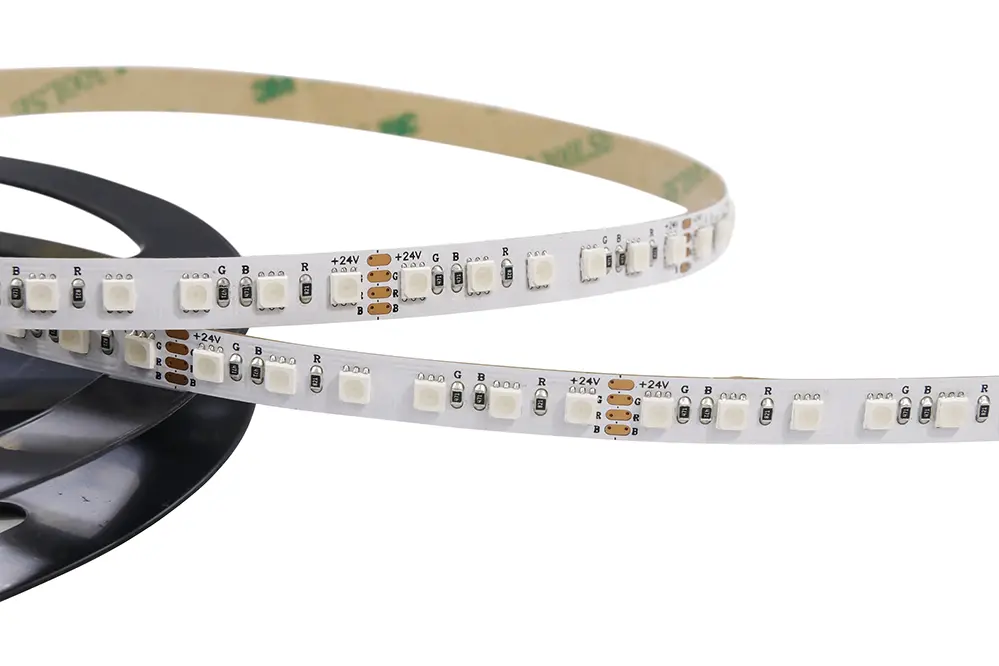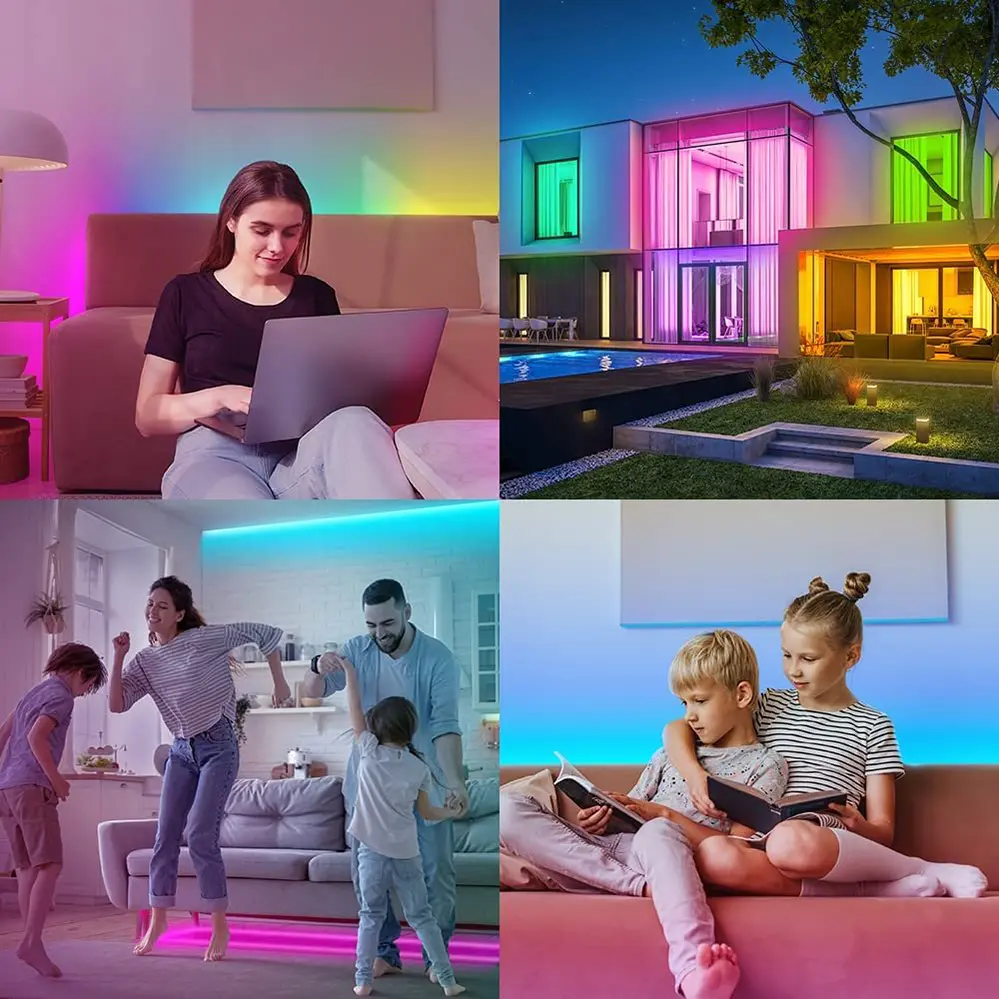How can you tell if your LED strip is addressable? This question is more than just a technical inquiry—it’s a gateway to unlocking a world of creative lighting possibilities. Many people are unaware of the differences between addressable and non-addressable LED strips, often leading to confusion and missed opportunities for stunning visual effects.
Addressable LED strips allow for individual control of each LED, enabling complex animations and color patterns that static strips can’t achieve. Yet, misconceptions abound, with many assuming all LED strips offer the same capabilities. This misunderstanding can lead to frustration when the desired lighting effects aren’t realized.
The benefits of addressable LED strips are vast, from enhancing ambiance in homes to creating dynamic displays in commercial spaces. They offer flexibility, energy efficiency, and the ability to transform environments with ease, often utilizing dmx512 for precise control. In this article, we’ll explore how to identify addressable LED strips, the technology behind them, and the myriad of applications they support.
We’ll cover key indicators of addressable strips, such as the presence of a data line and specific chip types, and provide practical tips for testing your strips. By the end of this article, you’ll be equipped with the knowledge to make informed decisions about your lighting setup. Join us as we delve into the fascinating world of addressable LED strips and discover how they can elevate your lighting experience.
Types of LED Strips

When exploring the captivating world of LED strips, you’ll encounter a luminous variety of options that promise to brighten your indoor and outdoor spaces with vivid splendor.
Two fundamental types of LED strips dominate the market: non-addressable and addressable.
Non-addressable LED strips emit a consistent, uniform light across their length, making them ideal for simple lighting tasks.
Conversely, addressable LED strips allow for intricate lighting patterns, where individual LEDs can display different colors simultaneously.
This distinguishing feature of addressable strips invites you to a world of creative possibilities, perfect for dynamic displays where individuality shines through pixel-perfect lighting control.
Whichever you choose, the power of light that’s ready to transform spaces awaits. Embrace this evolution and find your unique path into customized lighting experiences.
What Makes an LED Strip Addressable?

Addressable LED strips possess the magical ability to individually control each LED, unlocking a world of creative potential that non-addressable strips simply cannot match.
These strips have built-in microcontrollers, often referred to as ICs, enabling each LED to function independently.
This key to customization empowers users to orchestrate dazzling lighting displays with a wave of color and movement, transforming any space into a canvas of visual creativity.
The embedded microcontroller technology operates by assigning unique addresses to each segment of the strip, enabling tailored interaction through digital programming. With this power, installations can “dance” in synchronization and unleash breathtaking sequences of animated effects.
Identifying Addressable LED Strips
Embarking on the journey to identify an addressable LED strip, one must look to specific features that set them apart. Addressable strips often exhibit a distinct series of small microchips – these are their integral controllers, vital for individual LED command.
To determine the presence of such microchips, examine the strip for a “data line.” This additional wire, alongside power and ground wires, is a hallmark of addressability. By consulting technical specifications or product documentation, the digital communication channel crucial for addressable functionality can be confirmed, empowering you to unleash sophisticated light displays with precision and flare.
Checking the Manufacturer’s Specifications
When determining whether your LED strip is addressable, the manufacturer’s specifications serve as an invaluable resource. These documents detail the technical capabilities embedded within the strip.
Reviewing the specifications can reveal indicators such as “addressable RGB”. Such terms are a beacon of the strip’s potential to render vivid, dynamic displays through individual LED control.
Addressable LED strips find their essence in unique programming, making them ideal for eye-catching displays.
Beyond product descriptions, specifications often include diagrams or illustrative images highlighting key components (data lines or microcontrollers), ensuring you have the right foundation for electrifying light sequences. These precise details empower you to orchestrate stunning visual symphonies effortlessly.
Identifying Control Chips
Control chips, which often include a built-in IC or an external IC, are the heart of addressable RGB LED strips, enabling dynamic lighting effects.
To identify control chips on your LED strip, examine the strip closely for small, embedded chips. These chips, generally close to the LEDs, act as the brain of the operation, managing signals that dictate the color and brightness of each individual LED. By referring to the strip’s data sheet or user manual, you may also find specific chip models, such as WS2812 or APA102, known for addressable capabilities.
Additionally, simply looking for a distinct data-in and data-out pin configuration can be a telltale sign of an addressable strip. This configuration suggests that each LED is capable of receiving individual signals, a hallmark of addressable technology.
Thus, gaining knowledge about these control chips not only confirms whether your strip is addressable but also serves as your entry ticket to programming and customizing brilliant displays. Empower yourself with this knowledge, and step confidently into a captivating world of programmable light artistry.
How to Test if an LED Strip is Addressable
Begin by examining the connector of your LED strip for individual data-in and data-out pins—an indicator of addressability.
For a more thorough inspection, check the packaging or provided documentation for technical specifications, such as “WS2812” or “APA102,” which confirm addressable functionality, further enhancing your creative potential.
Remember, “addressable” and “non-addressable” refer to a strip’s ability to customize each LED individually.
Using a Controller
Addressable LED strips need a controller.
A controller is essential for operating the diverse effects of an addressable LED strip. This device enables you to send the precise commands necessary to activate various colors, patterns, and sequences, unlocking an array of lighting possibilities. Typically, these controllers are designed to work with specific protocols like SPI or DMX, such as DMX512, which support advanced effects.
The choice of the controller matters significantly.
Make sure to choose a controller that is compatible with your LED strip – its chip type should match the controller’s specifications to ensure seamless integration. Additionally, wireless controllers or those with smartphone app support can provide even greater flexibility.
With the right controller, addressable LED strips can be transformed into captivating visual experiences, resonating with the spirit of innovation and creativity as we step boldly into the vibrant world of 2023. This alignment between technology and artistic expression is truly the cornerstone of mesmerizing lightscapes and personalized lighting environments of the future.
Testing with Software
Testing your LED strip’s addressability can be efficiently conducted using software tools, which simplify the identification process.
- Select the Right Software: Choose a program or application that matches your LED strip’s protocol (e.g., SPI or DMX).
- Connect Your LED Strip: Use a compatible controller to connect the LED strip to your computer or mobile device.
- Run a Color Test: Initiate basic color patterns to observe if individual LEDs display different colors.
- Check for Control Software Features: Investigate software capabilities for customizing individual LED controls.
- Analyze the Response: Ensure the entire LED strip responds correctly to commands, verifying its addressability.
A successful software test confirms whether each LED can be controlled independently.
This method, incorporating an external IC, not only verifies addressability but also enhances your ability to create stunning, personalized lighting effects.
Benefits of Addressable LED Strips
The future of lighting design is here.
Addressable LED strips present a plethora of creative possibilities. They offer the ability to control each LED individually, allowing you to produce dynamic patterns of changing RGB colors. Consequently, you can use them to create immersive experiences in various settings. Significantly, they add a fresh dimension to environments by enabling personalized lighting scenes tailored to suit specific moods.
Efficiency is another advantage that addressable LEDs bring, especially in terms of minimizing voltage drop across longer strips.
Their unique design allows for energy-efficient setups – not only can these strips reduce the overall power consumption of an installation – but they also maintain optimal performance even in more complex configurations.
These versatile tools provide enhanced interactivity with synchronized lighting effects, positioning them as a hallmark of innovation in 2023 and beyond the lighting landscape. Their integration into numerous applications signifies their remarkable utility, demonstrating how technological advancements make captivating lighting experiences a reality.
Common Applications for Addressable LED Strips

Versatile and innovative, addressable LED strips can do much.
They are an exceptional choice for smart home systems. With the ability to sync them with various smart devices, users can create personalized atmospheres with ease. Importantly, their adaptability and straightforward integration into home automation systems enable homeowners to design unique lighting experiences seamlessly.
Entertainment thrives with these LED strips.
Events and concerts regularly employ LED strips with DMX512 capability to – not only amaze audiences with vibrant light shows synchronized to music – but also enhance overall ambiance, transforming venues into visually stimulating wonderlands.
In creative projects, addressable strips support multimedia installations and interactive displays, shaping the art landscape 2023 and beyond with their boundless potential. Through these applications, addressable LED strips continue to inspire innovative minds, proving technological elegance can elegantly enhance artistic expression across the globe.
Troubleshooting Addressable LED Strips
Addressable LED strips sometimes face technical challenges, yet all is fixable. By following a systematic approach, you can solve issues. The first step is to check the power supply, which should match the strip’s required voltage and amperage specifications to prevent a voltage drop that could affect performance. Occasionally, connectivity problems may arise due to faulty wiring or connectors.
Test the individual LEDs with a multimeter.
If certain sections fail to light, check for broken connections. Ensure that the data input is properly aligned and free from obstructions. Verify that the controller is correctly configured for the specific strip in use.
In the ever-evolving world of technology, firmware updates can hold the key to resolving persistent issues. Regularly check for updates released by manufacturers to ensure your LED strips remain at peak performance. This proactive approach not only enhances functionality but also extends the life of your investment, ensuring vibrant lighting experiences persist.
Purchasing Tips for Addressable LED Strips
When embarking on the journey to purchase addressable LED strips, knowledge and forethought can significantly enhance the experience and outcome.
Firstly, it is crucial to understand the differences between various LED strip models. Addressable LED strips offer individual control of each LED, providing a broader canvas of creativity for dynamic lighting patterns. Knowing this distinct capability can greatly enhance your decision-making process, empowering you to select products that meet your specific lighting aspirations.
Moreover, verify the specifications of any potential purchase. By examining parameters such as voltage, wattage, and color output, you’ll ensure compatibility with your existing systems and avoid any operational setbacks that may arise.
Equipped with a comprehensive understanding of features such as the number of LEDs per meter and the waterproof rating, you’ll be well-prepared to make informed choices. This vigilance serves to amplify the possibilities for designing vibrant and adaptable lighting solutions that can transform any space, inspiring a lively and modern ambiance within your environment.
Final Thoughts on Choosing LED Strips
Selecting the right LED strip requires a strategic approach, ensuring that your choice aligns with your creative and technical goals.
Reflecting on the myriad options available, it becomes apparent that an addressable LED strip can offer unparalleled versatility, enabling elaborate lighting designs that cater to a broad spectrum of needs. For those seeking to elevate spaces through visually stunning effects, understanding these advanced functionalities can unlock a world of possibilities and drive confidence in your investment.
Fundamentally, focus should remain on a harmonious integration of the strip with existing setups. By addressing technical requirements and creative ambitions, the chosen LED strip can seamlessly blend into your space, delivering both beauty and high performance for any setting.
Ultimately, your well-informed selection of LED strips can transform a simple concept into a visual masterpiece, illuminating spaces with captivating and dynamic lighting. The pursuit of excellence in lighting not only reflects your style but also enhances the aesthetic and functional essence of any environment, leading to truly inspiring results.
Conclusion
Discovering how to identify addressable LED strips can significantly enhance your lighting experience, offering a level of control that transforms ordinary spaces into vibrant, dynamic displays. These advanced strips, equipped with digital control chips, allow for individualized manipulation of each LED, enabling you to craft stunning visual effects that reflect your unique creative vision. By following a comprehensive guide, you can easily recognize the features of addressable LEDs, empowering you to explore cutting-edge lighting technology with confidence and precision.
Embracing the possibilities of addressable LED strips opens a world of creative opportunities, allowing you to design illuminated spaces that captivate and inspire. These strips not only enhance the ambiance but also speak volumes about sophistication and innovation, making them an ideal choice for those seeking to elevate their environment. With the ability to create unique lighting arrangements, you can transform any space into an artistic canvas, showcasing your design aspirations and technical prowess. Dive into the future of lighting and let addressable LEDs illuminate your path to creativity and elegance.





